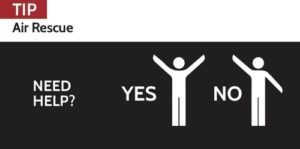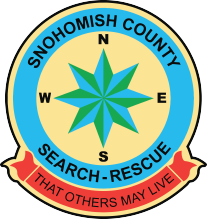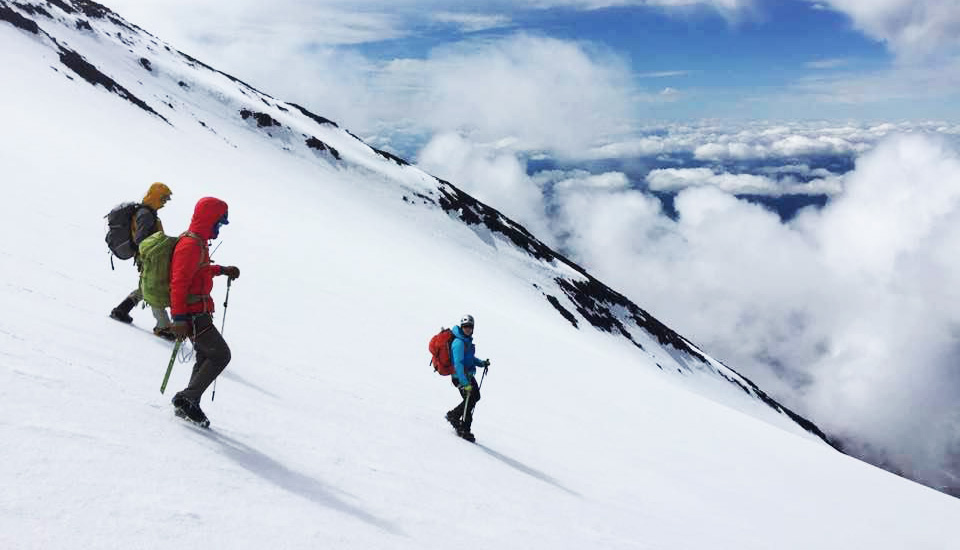Return to the blog
When should you call 911 for Search and Rescue? What happens when you do?
January 25, 2017
Whether you consider yourself a hard-core outdoor enthusiast or just an occasional backcountry explorer, learn more about when you should call Search and Rescue, what information you should provide, how long a typical response takes, and more.
QUESTION: How do I call Search and Rescue?
ANSWER: The only way to get in touch with Search and Rescue in Snohomish County is to call 911. The initial call may be handled by King County, Washington State Patrol or other dispatch agencies depending on where you are.
Explain the nature of your emergency and, if you are in the backcountry, where you are and the trailhead you accessed. 911 will need this information in case you need to get transferred to SNOPAC for the Snohomish County Sheriff. They will have someone from Search and Rescue call you.
QUESTION: What if I don’t have cell service?
ANSWER: You can try texting 911 regardless of if you have cellular phone services available at your location.
You may be instructed to turn off the phone to conserve battery life, and turn it on at scheduled intervals to text 911 and update them on the patient’s status. (Click here for more information about Text to 911 services in Snohomish County).
If there is no cell service at all, STOP: stop, think, observe, and plan. Stay put and give yourself time to take stock of the emergency and decide on a plan of action. If an individual in your party is injured, cannot move at all, talk over a plan to send somebody for help. Depending upon your location you may be able to get cell service by moving up or down the trail or up or down one of the geographical features close to you or hiking out to a trailhead.
STOP: STOP, THINK, OBSERVE, PLAN
QUESTION: When should I call Search and Rescue?
ANSWER: Search and Rescue responds in a variety of ways to many situations. We can help both the lost and injured. From a medical standpoint, anytime you are in the backcountry and someone is having an airway or breathing problem or a circulatory problem, such as uncontrolled bleeding, it’s always appropriate to call Search and Rescue. If you or someone in your party is immobile (e.g. unable to walk), that’s also a good reason to call Search and Rescue. Time of day also makes a difference. If you are trying to get yourself or someone out of the backcountry but not making progress fast enough, it is definitely time to call Search and Rescue. We do respond after dark, but response will be limited by the conditions. We may use helicopters after sunset but we only do so for truly life and death situations due to the tremendous risks and complexity. Call as soon as you think you are in trouble – if you wait until dark it may take us much longer to get to your location.
QUESTION: What if I’m off-route and I don’t know what to do next? Is Search and Rescue able to offer instructions or advice over the phone as opposed to sending people into the field?
ANSWER: Yes. We are not a guide service, but on occasion – when people are lost or off-trail, we may be able to provide some assistance in locating them. If people are off-trail in terrain that is dangerous we may be able to help get them out of that terrain as well.
QUESTION: What information will I need to provide Search and Rescue when I call in an emergency?
ANSWER: When you call 911 the dispatcher will ask for your name and contact information first so that if for some reason connection is lost there is a chance of getting back in touch with you. Other information needed includes the nature of the emergency, such as whether you are lost or have a medical emergency or injury.
If you are calling for a family member or friend that is overdue, 911 will need the following information:
• Where did they park, and what were they driving?
• How many people in the party?
• How were they equipped, clothing? extra food? Water? emergency beacons?
• Are they familiar with the terrain or trail?
If you are with the injured person and calling 911:
• What is your location? Can your mobile phone provide coordinates (lat/long)?
• Is the patient conscious and breathing normally?
• What kind of injuries?
• What kind of medical history may affect the patient, previous heart attacks, diabetes, etc.?
• Can they move on their own, or will they need assistance?
• Can you estimate how far you are from the trailhead, or how long it took you to hike to your location?
Other helpful information can include the number of people in your party, your geographic location, and any landmarks close by. Also, the description of the clothing your party is wearing.
Consider leaving a hiking or trip plan with someone, including what time you are leaving, what time you expect to be back, where you are going. Include what time someone should call 911 should you not return. Follow-up with a call to those who have your trip plan as soon as you return home.
QUESTION: How long should I expect it to take for Search and Rescue to respond?
ANSWER: Once the call comes into 911, dispatch will page a sheriff’s SAR deputy who may call back for more information. The deputy will determine the appropriate response. A ground response can take several hours depending on many factors including availability of team members, driving distance, hiking distance, weather, terrain, required equipment, and time of day/night. If the situation is such that we are able to launch a rescue helicopter our goal is to be airborne within 60 minutes from the initial alert from the SAR deputy.
QUESTION: How should I prepare for the arrival of Search and Rescue? Is there anything I can do to assist rescuers?
ANSWER: If a member of your party is injured, utilize appropriate first aid and, if their condition allows, ensure they are comfortable. Make sure they stay warm and are off the ground – you can insulate them from the cold with a sleeping bag or pad, or extra clothing. Be searchable: make yourself visible and easy to find. If you are off-trail, try to move away from running water which can make it hard to hear if people are yelling for you. Try not to hunker down in tree cover. If you are expecting a helicopter to come, move away from the trees so you are more visible from the air. At dawn and dusk, headlamps, flashlights, glow sticks, or other light sources are helpful for searchers. Signal mirrors for air operations may also be helpful. A whistle is easy to carry with you and excellent for carrying sound – you can sustain blowing on a whistle much longer than screaming.
QUESTION: What is the best way to communicate with the helicopter crew once they are overhead?
ANSWER: Waving two arms overhead is a signal to us that you need help, but the best signal is to wave a jacket, t-shirt, or other large item. Raising one arm up is confusing. Many hikers see us overhead and wave hello with one arm up. They are not calling for assistance but when we are trying to determine who needs help it causes confusion.

To wave off a helicopter, cross both arms overhead and shake your head “NO”.
If the air crew is low enough that they have used hand signals from the aircraft, use the universal sign for “OK”, first pointing to the subject and signaling “OK?” to the person on the ground and they signal back with the “OK” hand signal.
If someone needs assistance and the helicopter cannot land, we may lower a handheld radio to facilitate communications.
QUESTION: What happens once SAR arrives on the scene?
ANSWER: Once the team arrives, we will to introduce ourselves and then it really depends on the nature of the emergency. We will assess the health and safety of everyone in your party. If people are cold, tired, hungry we will try to alleviate that immediately. If there is an injury, we’ll provide whatever medical support we can. Then, we will start planning for how to get you and your party out of there safely. Sometimes we may use a wheeled litter for someone who is immobile so they can be wheeled down the trail. Other times we may request helicopter response. We can respond with helicopters, mountain bikes, horses, snow machines, watercrafts, 4x4s, and 6x6s. We have many specialized rescue techniques we can use for very technical terrain, like rope rescue or helicopter hoists. However, when the situation allows it, we will try and walk somebody out to get them down the trail.
QUESTION: How much will it cost me to be rescued?
ANSWER: Not a penny. In most counties in Washington, there is no charge. Although in other states or places there may be. Snohomish County Volunteer Search and Rescue (SCVSAR) is an all-volunteer non-profit organization delivering emergency response to those in need across the county’s urban and wilderness areas. Our dedicated members are not paid and we come to the aid of anyone lost or injured wherever they might be without charge to the subject or family. We find children, search for lost people with dementia, mental health issues, and developmental challenges, respond to major disasters, and perform life-saving first aid and CPR. SCVSAR has over 300 dedicated volunteers and our capabilities include helicopter rescue, 4×4 rescue, wilderness and urban search, K-9, horseback, swift-water, mountain recovery, and emergency first aid.
We operate in coordination with the Snohomish County Sheriff’s Office and the Snohomish County Department of Emergency Management. Each year our volunteer team members respond to over 100 lifesaving missions, logging 9,200 direct mission response hours and 20,500 training, meeting and public event hours for a total of 29,700 hours of volunteer service to our community. The great amount of training that our volunteers go through ensures that we are “mission ready” at a moment’s notice and available 24/7.
As an all-volunteer organization, each year we need to raise sufficient funds to maintain our organization. We need to maintain our training facilities in Snohomish which houses our rescue trucks, our hovercrafts and our helicopters. In addition, we regularly need to replace highly specialized equipment, like our rigging gear and rescue ropes. Volunteers pay for their personal equipment out of pocket.
Snohomish County Volunteer Search and Rescue wishes to acknowledge Backcountry Zero, Teton County Search and Rescue Volunteer and Medical Director, Dr. AJ Wheeler which graciously gave permission for us to adapt the above Q&A to be applicable to Snohomish County Search and Rescue operations. See the original article, HERE.
For more information on Snohomish County Volunteer Search and Rescue, please visit our website at https://scvsar.org/


 Donate
Donate



